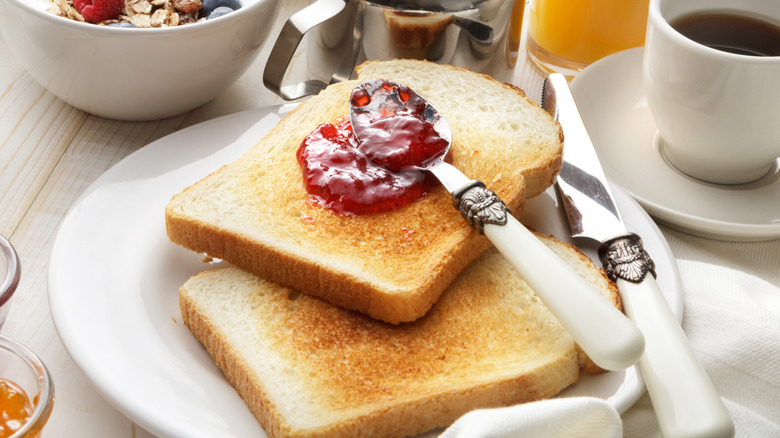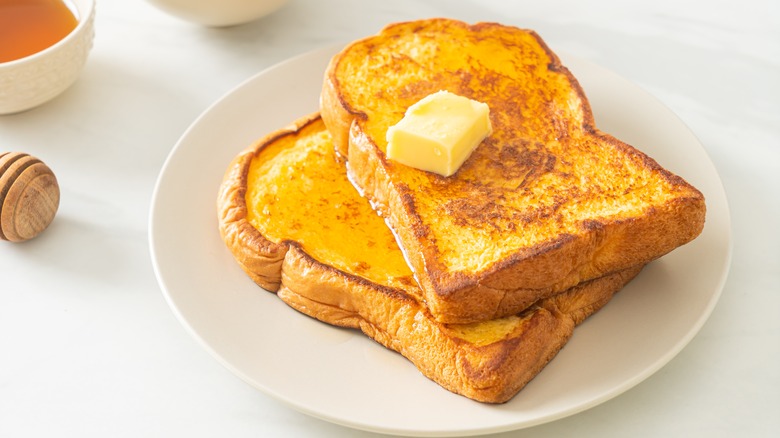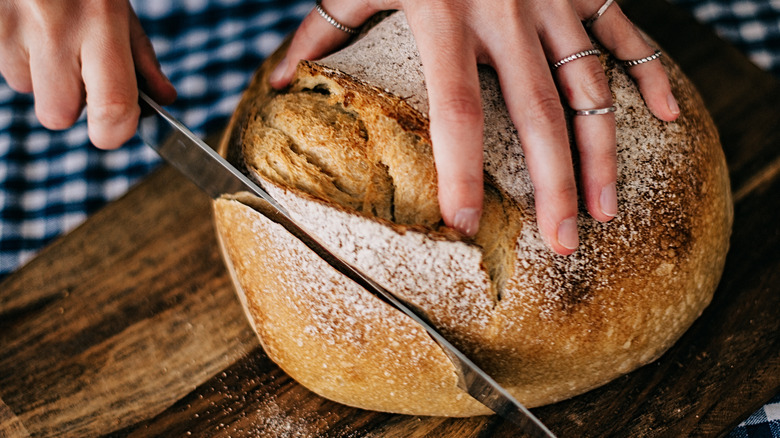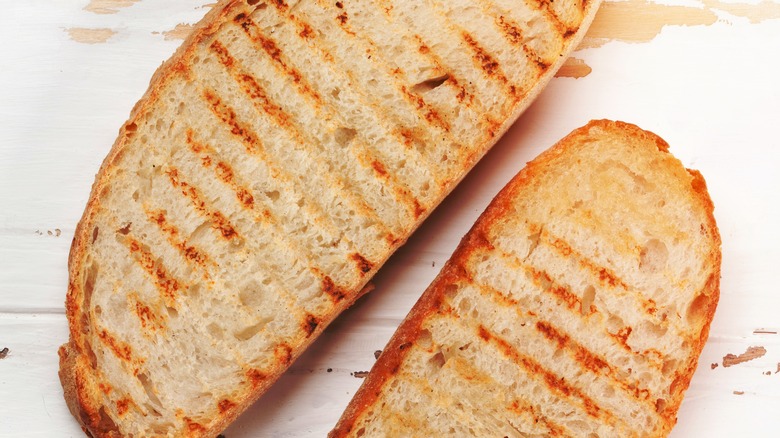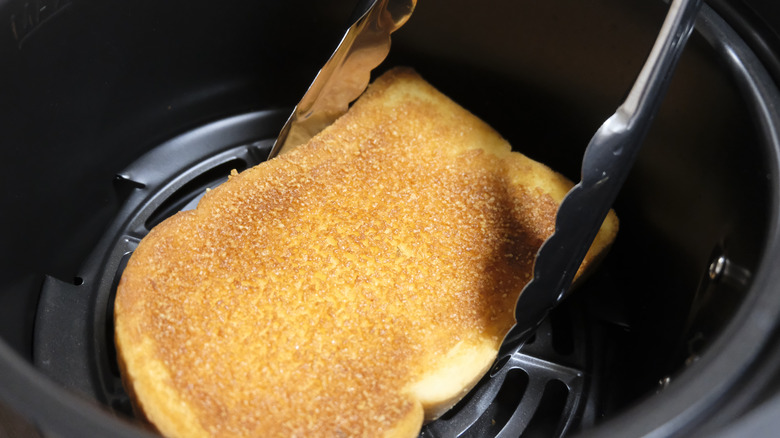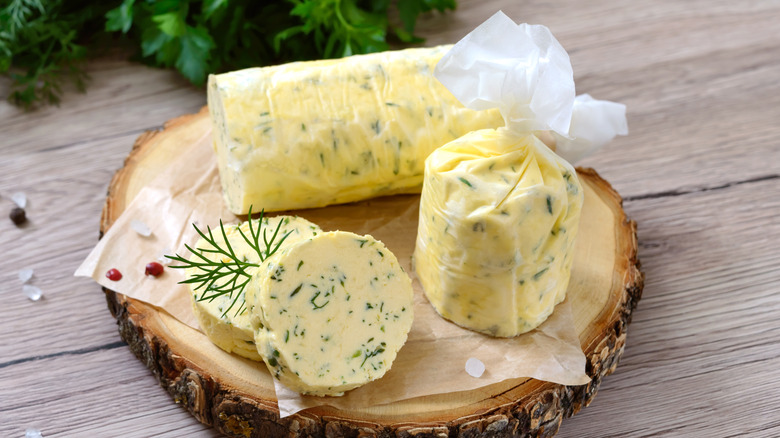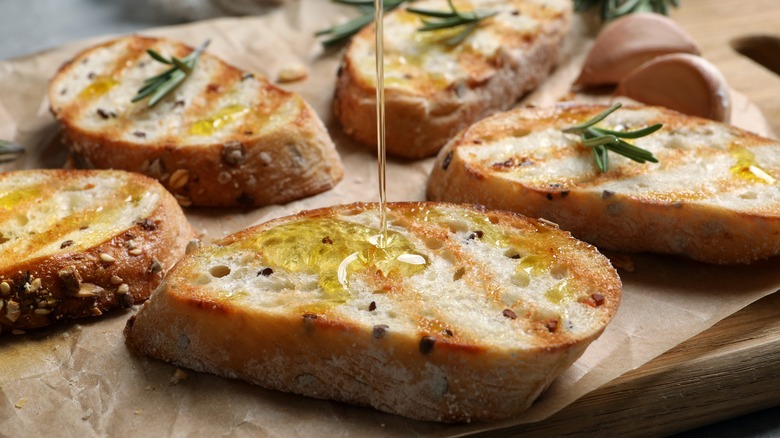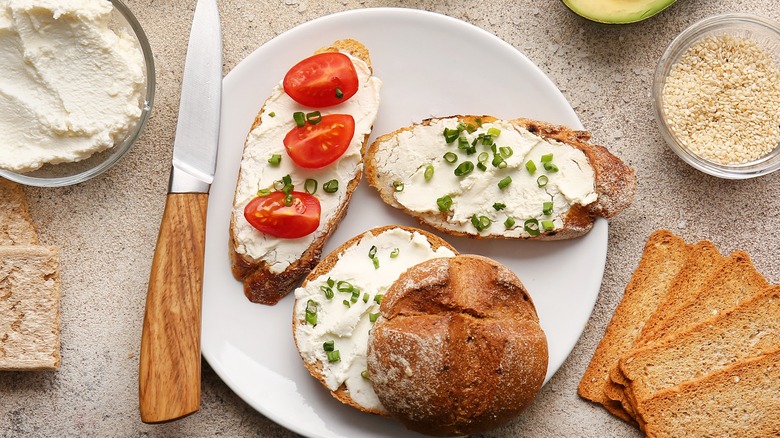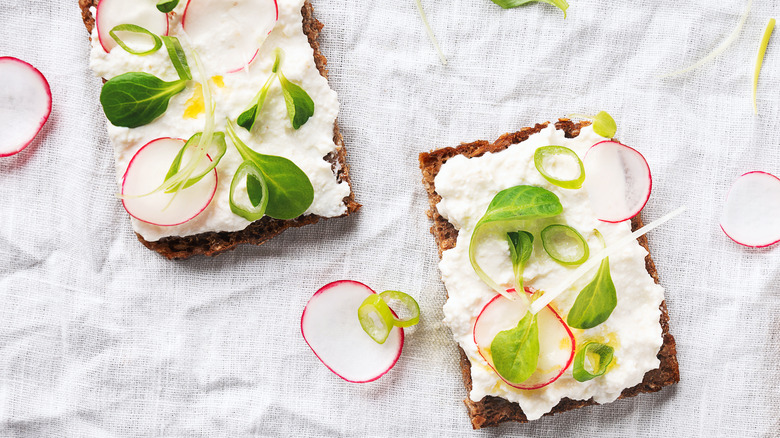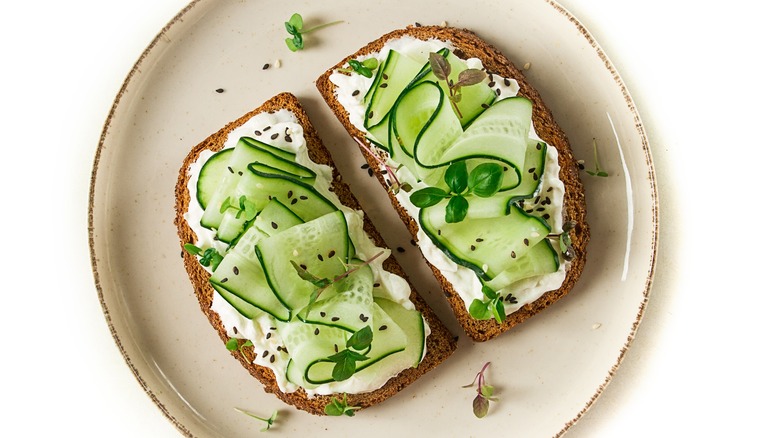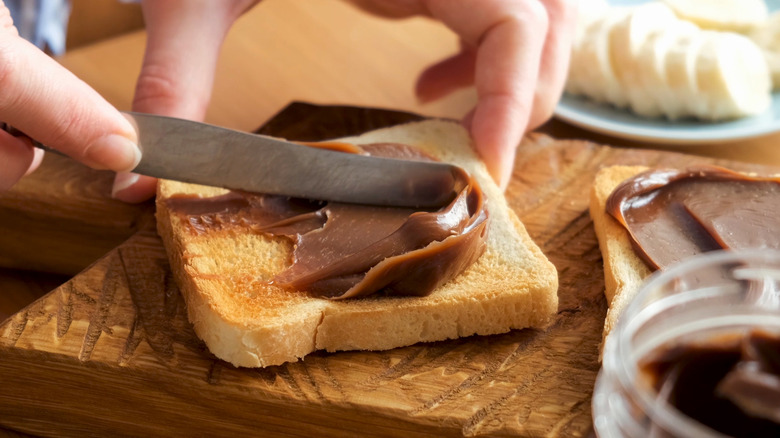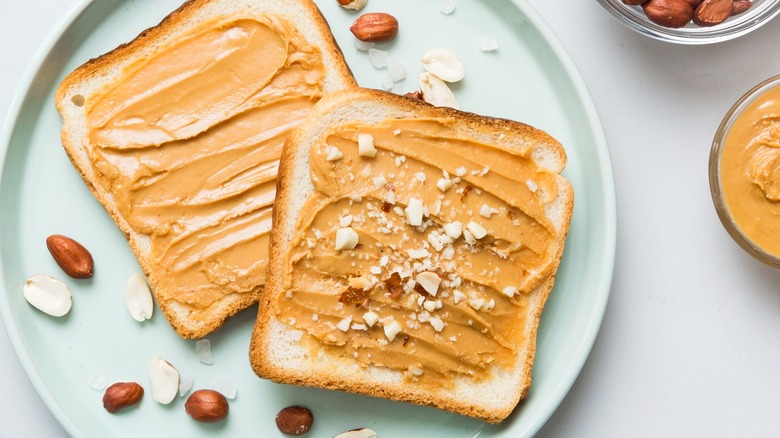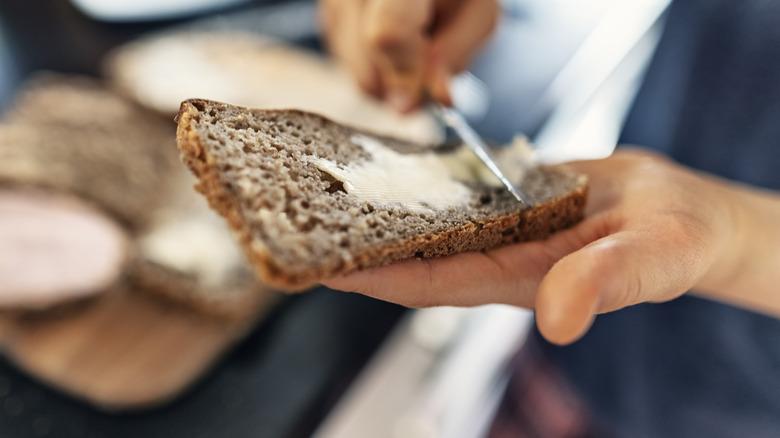12 Ways To Take Your Toast To The Next Level
In 2018, archeologists studying a historic site in the country of Jordan unearthed a fossilized piece of bread dating back more than 14,000 years — the first ever documented loaf of bread in human history. Although these researchers didn't have the same luck discovering it, we're betting the first-ever piece of toast was made just an hour or two later — as soon as that bread got cold and somebody decided they were going to find a way to make it ... well, nice and toasty warm again.
When it comes to foods that are seemingly "perfect," toast ranks high on the list. It's comforting. It's inviting. It's crunchy, nutty, savory, and delicious. Toast is also easy to make, versatile, and pairs well with almost everything, from hot coffee and tea to eggs, fruity jams and jellies, and even sweet and decadent spreads.
And that's just the start! Because as wonderful as a slice of toast is — straight from your toaster or oven and coated with a layer of melting butter — it can also be made even better. That's right ... toast is a perfect food, but also one that can be taken to even greater levels. Want your toast to be even richer, more flavorful, nuttier, creamier, and even toastier than it already is? We do, too, so keep reading!
1. Choose more interesting breads
Even the most basic, discount, soft and fluffy slab of white bread can make a good piece of toast from time to time. But if you really want to take your toast to the next level, you can do better. The easiest way to upgrade your toast is to opt for a higher-quality loaf.
Think of this hack as one that can be done in stages. If you're a white bread aficionado, don't immediately reach for a slice of sprouted pumpernickel. Level up gradually so your taste buds won't be too shocked, and you can gradually learn to appreciate the more nuanced aspects of bolder loaves. From white bread, venture into whole wheat and multi-grain options.
From there, you can start to explore sourdough, rye, and oatmeal bread. And beyond that, there's still so much to sample: honey wheat bread, cinnamon raisin, sesame seed bread, cranberry walnut — the list goes on and on. You can also try making your own homemade bread to toast — banana bread is a wonderful option for even novice bakers. And don't forget bread variants like focaccia, brioche, and challah, all of which also make an exceptional partner for your morning plate of scrambled eggs and bacon.
2. Slice your own bread
In addition to the type of bread you use to make your toast, another key factor in how every piece of toast you make turns out is the thickness of the bread you use. When you buy pre-sliced bread, there isn't much you can do about this. But buy your loaves whole, fresh from the market or bakery, and you can slice that bread yourself — and create the foundation for incredible toast in the process.
Slice that challah or rye extra thin, for example, and you'll be rewarded with uber-crisp, light, crunchy toast that verges on the flavor of a warm, toasted cracker. Thickly sliced ciabatta or whole wheat bread, on the other hand, is going to be nuttier and earthier than a standard slice. These larger chunks of bread aren't just going to be chewier and more substantial; they'll also pack a much more pronounced bread "flavor." All of these qualities — for both thinly sliced and thickly sliced bread — will carry over to the toast you make.
Give it a try! Buy a fresh loaf of any bread you love, and then slice it yourself. Then, when you're done, marvel at just how much better your toast really tastes. It's a game-changer.
3. Say goodbye to your toaster
Once you start to sample (and slice) new breads, the next way to whip up some next-level toast is to step outside the box ... a.k.a. your toaster. There are countless ways you can make a slice of toast — starting right this minute! — that don't require any special supplies or tools beyond what you already have in your kitchen.
For instance, your stovetop is an ideal vehicle for making toast. Just grab a skillet or grill pan and place it over medium heat. You can toast your bread by lying it on that hot surface for one to two minutes per side. Your oven is another great, although slightly slower, toasting option. Place a wire rack on a baking sheet and then arrange slices of bread on the rack in a single layer. Then, put everything in the oven to bake for 10 to 15 minutes. Flip the slices halfway through, and let them cook until golden brown and crisp on both sides.
To make toast in a hurry using your oven, you can also simply click on your broiler. Then, put a few slices of bread on a baking sheet placed directly under the broiler element. Toast the bread for one to two minutes per side. Watch closely as the bread toasts — broilers are hot, and your bread could burn easily.
Try these toasting techniques and see which is your favorite. Each toasts bread slightly differently, so pick the method your taste buds appreciate most.
4. Make your toast in an air fryer
Beyond your stove and toaster, you can also make delicious toast on an outdoor grill. Just let your grill heat until warm, brush both sides of your bread with olive oil to prevent sticking, and then grill for one to two minutes per side, or until the bread develops grill marks and reaches your favorite level of crispiness.
Air frying is another next-level option for making for making incredible toast. Air-fried toast tends to be crispier overall than toast made in other ways since the hot air is free to circulate the bread. This ensures much more even cooking, so your toast is crisp and golden all over — not burned in some spots and soft in others, as you might get with a standard toaster.
To prepare air-fried toast, first, preheat your air fryer to around 350 degrees Fahrenheit. Then, place your slices of bread in a single layer in the air fryer basket. Let the bread toast for about three to five minutes, depending on how browned you like it. In larger air fryers, you shouldn't need to flip your toast. However, in smaller appliances, turning the toast may still be necessary to make sure you get an even golden brown all over.
While you're at it, save yourself the mess and cook your morning eggs in your air fryer as well. They'll turn out just as perfect, and delicious, as your toast!
5. Upgrade your butter
Toast's up? Grab the butter. But not just any butter. To make elevated, next-level toast, you need exceptional butter. You can start seeking these tasty "alternate" butters on your next trip to the grocery store. When standing in the dairy aisle, deciding what to buy, don't just grab your standard salted or unsalted stick of choice and call it a day. Whipped butter is a step in the right direction. It's lighter and airer than standard butter, so it spreads more easily, helping you to smear even more savory goodness onto your toast.
You might also see "raw butter" in your market. This butter is made from unpasteurized cream and is often more vibrant and robust in flavor than the regular" stuff. "Cultured butter" is a bit like yogurt and includes live bacteria cultures — think of it as the sourdough or buttermilk of butter, with added flavor and tang. Grass-fed butter can give your toast more of an earthy, herbaceous quality. And if you've never tried it, throw some European-style or French-style butter in your cart too. They'll be a bit pricier, but each contains more natural butterfat, making them a richer and creamier version of the butter you already know and love.
And don't forget flavored butters, which are infused with various herbs and spices. With additives like garlic, basil, rosemary, citrus zest, and honey, they too are an excellent way to add even more richness and flavor to your standard slice of toast.
6. Add spices or seasonings pre-toasting
Next-level toast doesn't just depend on quality bread or toasting. It also requires loads of flavor! Butter and jam alone are simply not enough. There are all kinds of marvelous ways you can add vibrant flavor to toast. A drizzle of olive oil or honey once the bread is toasted is a good start, but you can also add even more flavor with herbs and spices.
To start adding richness and intensity before your bread is toasted, consider giving your bread a "garlic rub." Simply peel and halve a clove of raw garlic and then rub it over the surface of the bread. Really work the raw garlic juices in there; don't rub too lightly. The more you press, the more you can impart that delicious, pungent garlic flavor into your bread — and toast. If you're making toast in the oven or an air fryer, you could also finely mince the garlic and mix it with olive oil. Brush this mixture onto your bread before toasting.
You can also add incredible flavor and spice to bread after it's been toasted. One of the most effective options is to sprinkle freshly chopped herbs like cilantro, chives, or dill over the toasted bread immediately after it comes out of the toaster. You can also sprinkle a light dusting of cinnamon, nutmeg, or cumin over warm toast before smearing on your butter. Citrus zest, chili flakes, and a favorite type of salt are also fantastic and flavorful options.
7. Use Greek yogurt or cream cheese in place of butter
With its salty yet sweet, creamy, rich essence, butter is undoubtedly a warm piece of toast's best friend. But when you're looking for elevated, next-level toast, there are also some other excellent spreads to consider, each of which is equally tasty and even more decadent.
Cream cheese is a great place to start. Many of us frequently spread a schmear of cream cheese on bagels, but the topping can be an afterthought with toast. We just don't pair the two as often — which is a shame, especially if you love cream cheese. With its thinner, crisper texture, toast lets you enjoy the luxurious, velvety texture of cream cheese even more than you do with a bagel (where it can sometimes seem lost amongst all that dough).
While you might not think of it as a spread, Greek yogurt is another fantastic rich and creamy spread option for toast. It's slightly sweet with a distinct tang. And it pairs well with all sorts of potential toast toppings, from berries and honey to granola, dill, and even smoked salmon. Yum!
8. Pair your toast with ricotta or cottage cheese
Like cream cheese and Greek yogurt, ricotta is another fabulous alternative to butter when making toast. It has a mild, subtle sweetness, spreads easily, and pairs with all sorts of added toppings. You can spread it on toast and then pile on fresh fruit, honey, tomatoes, and herbs — the flavor combinations are endless. Just spread the ricotta on with a knife, just as you would a dab of butter, season with some salt and pepper (if you like), and add your other toppings.
Cottage cheese is a lot like ricotta in many ways. (It can even substitute for ricotta in lasagna and other zesty Italian pasta dishes — that's just one of cottage cheese's many unique uses.) Cottage cheese is also a world-class topping for any variety of warm and crispy toast. It spreads easily, and those lumpy curds give toast an added texture and chew you don't get with smoother spreads like butter or margarine.
Just grab a spoon and spread a dollop or two of cottage cheese on your warm toast. Season with salt and pepper, if you like, and then add any additional toppings you're in the mood for. For a sweet pick-me-up, top your cottage cheese toast with sliced strawberries, peaches, or bananas, along with a drizzle of honey or a sprinkle of cinnamon. For a savory treat, try adding sliced tomatoes, avocado, cucumber, or smoked salmon, along with salt and pepper to taste.
9. Pile fruit, veggies, and herbs on your toast
Whether you end up topping your toast with butter, cream cheese, ricotta, or even sour cream, don't stop there. Each of these dairy staples is the perfect base for all sorts of added fresh vegetables, fruits, and herbs — each of which will help to make an already good piece of toast into a culinary masterpiece.
Sure, you already know about (and have likely tired of) avocado toast. But how about some toast topped with sliced strawberries, baby spinach leaves, and a drizzle of balsamic glaze? Or, top that crispy toast with sliced peaches, creamy ricotta cheese, and a dab of honey. Craving something more savory? How about toast garnished with fresh fig slices, tangy goat cheese, and thyme leaves?
Thinly sliced pears, crumbled Gorgonzola cheese, and toasted walnuts make a spectacular slice of toast. So do roasted red pepper strips, creamy hummus, and peppery arugula leaves. For a bit of heat, how about toast with a thin layer of cream cheese, thinly sliced radishes, a few chunks of ham, and some fresh dill leaves? Or, our personal favorite: grilled pineapple slices, creamy coconut butter, and chopped macadamia nuts. Mmmmm.
10. Try alternate spreads
A great spread for toast doesn't have to be dairy-based. Jams, jellies, and marmalades are all fantastic options. But for next-level toast, think even bigger too. We're not talking PB&J toast, either — consider what you would use if you were out of peanut butter. Maybe you use a luscious hazelnut spread, or some cashew or almond butter? Coconut butter, pumpkin seed butter, and sunflower seed butter are all inspired and incredibly delicious possibilities.
Tahini (which is made from a mixture of spices and ground sesame seeds) is an extraordinary addition to toast. You could also coat your toast with a plain or flavored hummus or an olive tapenade. For a savory breakfast toast that sings when paired with a side of eggs and bacon, how about some toast topped with pesto, a tangy salsa, or even a white bean dip? You could also put leftover baba ganoush on your toast, or even umami-packed miso butter — essentially just traditional butter blended with some classic miso paste.
Ever heard of "Princess Toast"? This cutesy, pastel-colored creation isn't just for little girls! For an indulgent and elevated alternative to butter, become a princess yourself and spread a premade or home spoonful of frosting on your toast. You could also send your toast into sweetness overload with a drizzle of maple syrup, colorful sprinkles, some marshmallow fluff, or even ever-popular cookie butter. The bottom line: If you can spread it, try enjoying it on some toast!
11. Add texture to your toast
In addition to experimenting with spreads, another spectacular way to elevate toast is with toppings that add texture, crunch, and chew. Diced or crumbled nuts are a perfect way to start, providing an earthy flavor that naturally meshes well with warm toast and your spread of choice. The nuts could come pre-mixed into the spread, like a crunchy peanut butter. Or, add them yourself — sliced or slivered almonds, crumbled or candied walnuts, glazed pecans, and chopped cashews or pistachios all work beautifully on toast.
To add a meaty edge to your toast, consider garnishing it with crumbled bacon, diced ham, a fried egg, smoked salmon, or even sautéed mushrooms. Grated Parmesan, Feta, and blue cheese crumbles are also brilliant additions to a slice of toast, as pretty to look at as they are to dig into.
For something a bit fruitier, how about sprinkling raisins, dried cranberries, or diced dried apples, bananas, or peaches on your toast? Dried apricots, cherries, and even tart dried pineapple are also sure to add flavor as well as chew and crunch.
And, for pure, unadulterated toast with texture and crunch, you can also char your bread, add a spread, and then top it with crushed graham crackers, crumbled potato chips or tortilla chips, pine nuts, shredded coconut, or even granola. For crunch and added nutrients, you might also consider sprinkling flaxseeds, chia seeds, or even a bit of nutritional yeast, which has a surprisingly tasty cheese-like quality.
12. Butter your toast before toasting it
Finally, when it comes to making net-level toast, one of the easiest and most effective ways to amp up your slice is to simply butter your bread before you toast it. Easy, right? Think of it like making a grilled cheese or even a toasted panini, only without all that added cheese or sandwich filling.
Of course, it's worth noting that you can only butter your bread before toasting it if you aren't using a toaster to char the bread. Putting a piece of butter-coated bread in a traditional toaster is a grease fire just waiting to happen — the butter will melt and drip all over inside your toaster, causing who knows what kinds of potential problems. Even if it doesn't cause any flames, it's sure to total your toaster.
Instead, use this technique only when making toast in your oven, on the stovetop, on the grill, or even in your air fryer. Spread a generous amount of butter on one or both sides of your bread and then get toasting! As the butter warms, it will melt throughout your slice of bread, rather than just pooling along the surface (like it does when you put your butter on later). Depending on how much butter you use, some may even help your bread sear against your skillet or sheet pan, creating a delightful, crispy, browned crust — let's see a regular toaster do that!

